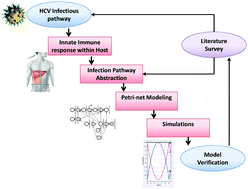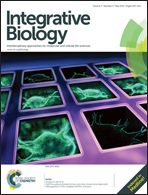Modeling and analysis of innate immune responses induced by the host cells against hepatitis C virus infection†
Abstract
An in-depth understanding of complex systems such as hepatitis C virus (HCV) infection and host immunomodulatory response is an open challenge for biologists. In order to understand the mechanisms involved in immune evasion by HCV, we present a simplified formalization of the highly dynamic system consisting of HCV, its replication cycle and host immune responses at the cellular level using hybrid Petri net (HPN). The approach followed in this study comprises of step wise simulation, model validation and analysis of host immune response. This study was performed with an objective of making correlations among viral RNA levels, interferon (IFN) production and interferon stimulated genes (ISGs) induction. The results correlate with the biological data verifying that the model is very useful in predicting the dynamic behavior of the signaling proteins in response to a stimulus. This study implicates that HCV infection is dependent upon several key factors of the host immune response. The effect of host proteins on limiting viral infection is effectively overruled by the viral pathogen. This study also analyzes activity levels of RNase L, miR-122, IFN, ISGs and PKR induction and inhibition of TLR3/RIG1 mediated pathways in response to targeted manipulation in the presence of HCV. The results are in complete agreement at the time of writing with the published expression studies and western blot experiments. Our model also provides some biological insights regarding the role of PKR in the acute infection of HCV. It might help to explain why many patients fail to clear acute HCV infection while others, with low ISG basal levels, clear HCV spontaneously. The described methodology can easily be reproduced, which suitably supports the study of other viral infections in a formal, automated and expressive manner. The Petri net-based modeling approach applied here may provide valuable insights for study design and analyses to evaluate other disease associated integrated pathways in biological systems.


 Please wait while we load your content...
Please wait while we load your content...